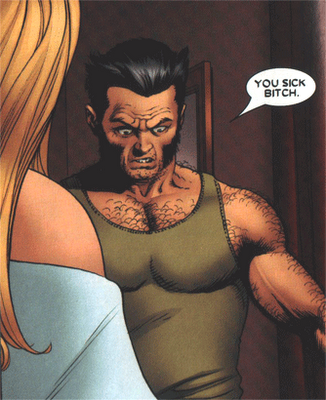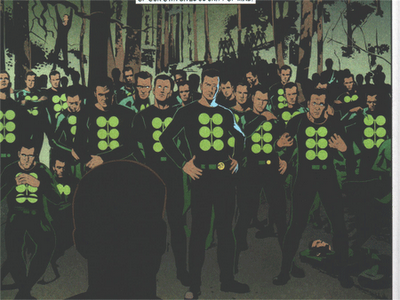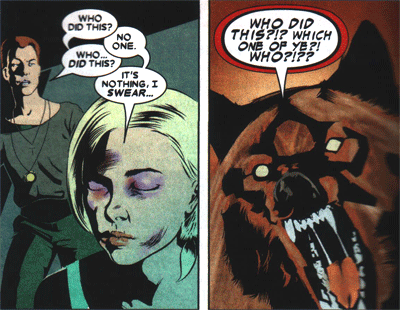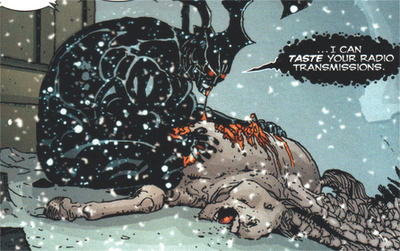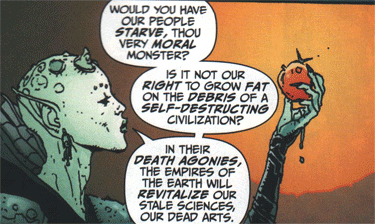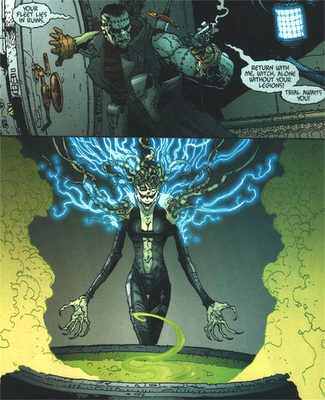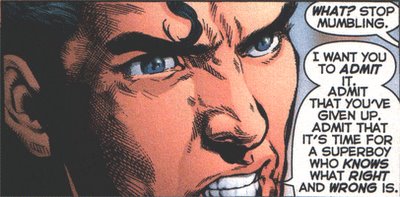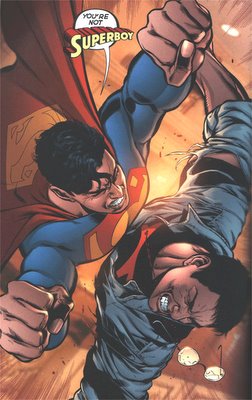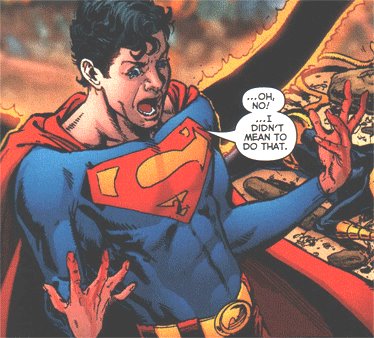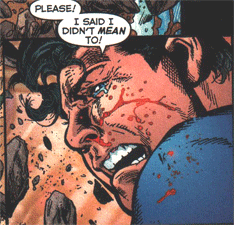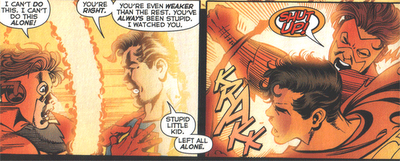 DC Comics
DC Comics 1989
Writer: Grant Morrison
Artists: Chas Troug,
Doug Hazelwood
Grant Morrison makes his first of four appearances on the countdown here. Animal Man was a mostly forgotten Silver Age character when Grant got his big stateside break on his revamp. The basics: Buddy Baker, by virtue of being to close to an exploding spaceship is given the ability to take on the natural abilities of any animal he comes into contact with (instead of, say, getting third degree burns or losing a limb). If he's around a bat he has radar, around a bird he can fly, around a...you get the idea.
It's Silver Age cornball at its height. But Grant made the correct decision, very early on in the run, of focusing more on Buddy himself, and his family, than on what fantastic abilities Buddy possessed. Paying the bills was just as important to the Bakers as saving the Universe.
That said, The Coyote Gospel has next to nothing to do with Buddy Baker, his family, or his abilities. Instead, it's Grant Morrison's howling, bizarre introduction to the DCU, a place he would always do his best work.
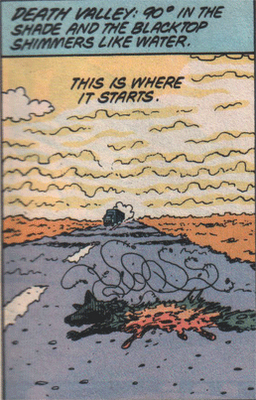 We begin with roadkill on the desert highway. Immediately we're given an image of nature under man's control, of destruction and violence.
We begin with roadkill on the desert highway. Immediately we're given an image of nature under man's control, of destruction and violence. But we're also shown the caring side of humanity, as we're privy to the conversation between a trucker and a runaway he's picked up along his route. He's full of stern, parental concern:
"I don't think you know how lucky you are I came along. Hitching In the desert is suicide, man."
"Yeah, well, the last guy kicked me out because I wouldn't, like, y'know..."
"Yeah, I know."
The trucker has a past in L.A., where young Carrie is heading. He offers her advice, turn back and go home. He knows the streets she'll be on soon. He also knows the road out:
 They drive on, singing along to the radio, their worries momentarily forgotten. Then, a shadow comes into the middle of the road, they slam into it head on. The girl is terrified, the trucker just stares ahead grimly. "Forget it, just don't look back."
They drive on, singing along to the radio, their worries momentarily forgotten. Then, a shadow comes into the middle of the road, they slam into it head on. The girl is terrified, the trucker just stares ahead grimly. "Forget it, just don't look back."But we don't follow the girl and the trucker down the road, we stay with their fresh kill.
 The creature writhes in the sun, his organs and bones reforming. From the narration: "A newly activated nervous system is suddenly jammed with frantic signals, like an overworked switchboard. The creature shudders, weeping. Its pelvic girdle fuses along hairline sutures, to cradle rapidly healing organs..."
The creature writhes in the sun, his organs and bones reforming. From the narration: "A newly activated nervous system is suddenly jammed with frantic signals, like an overworked switchboard. The creature shudders, weeping. Its pelvic girdle fuses along hairline sutures, to cradle rapidly healing organs..." Grant's words give the creature vivid, disgusting life. He rises to his feet and, like any good movie monster, stares at his audience.
Grant's words give the creature vivid, disgusting life. He rises to his feet and, like any good movie monster, stares at his audience. 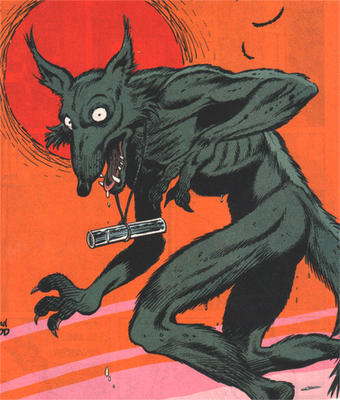 From the very beginning, we see there's something different about this beast. Something...strange, goofy, ok I'll say it: Looney.
From the very beginning, we see there's something different about this beast. Something...strange, goofy, ok I'll say it: Looney.Our friend Crafty is none other than Wile E. Coyote, Christ figure.
We rejoin the trucker, but he's much different. The silver cross is gone, and his head is shaved. His 'friend' Billy has died in an accident, his mother is dead of cancer, and he finds out that Carrie has been killed in a drug raid, after living as a prostitute in L.A.
He has lost the gentle, loving look in his eyes. He's a desperate, scared man. He has come to blame his loss on the devil. And the devil, in his eyes, is Crafty. Only by destroying the beast can he soothe his heart, and deal with his loss.
He finds Crafty and blows him off a high desert cliff. Any fan of Chuck Jones knows where this is heading:
 Troug and Hazelwood are not amazing artists, their style was pretty much par for the course in 1980's comics: just good enough to not be distractingly bad. But they do a wonderful job of recreating typical cartoon moments like the ones above, and I love this reaction shot,
Troug and Hazelwood are not amazing artists, their style was pretty much par for the course in 1980's comics: just good enough to not be distractingly bad. But they do a wonderful job of recreating typical cartoon moments like the ones above, and I love this reaction shot, 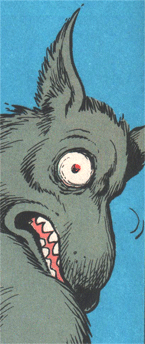 which is as close to eyes popping right out of Crafty's head as his new, more dynamic anatomy will allow.
which is as close to eyes popping right out of Crafty's head as his new, more dynamic anatomy will allow. But to the trucker he is Satan incarnate. That's the only thing his Christian background will allow him to see Crafty, and nature in general: as tools of the devil.
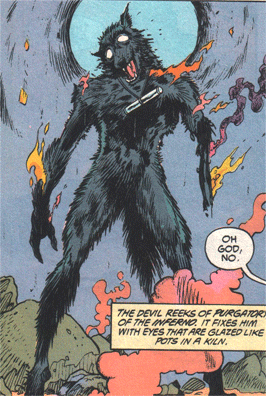 This is not to say that the book is an attack on Christianity. The trucker is every bit as pathetic and pained as the coyote. But his single minded obsession with defeating evil blinds him to the fact that he shares Crafty's pain.
This is not to say that the book is an attack on Christianity. The trucker is every bit as pathetic and pained as the coyote. But his single minded obsession with defeating evil blinds him to the fact that he shares Crafty's pain. 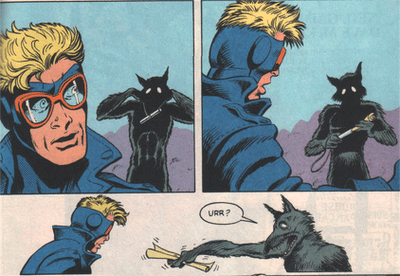 Crafty seeks out Buddy, and it is Buddy that he gives his grand message of faith to: The Gospel According to Crafty.
Crafty seeks out Buddy, and it is Buddy that he gives his grand message of faith to: The Gospel According to Crafty. Crafty comes from a world where constant, meaningless violence is accepted as the norm and never questioned. Where cartoon critters maim and explode each other endlessly for the entertainment of a cruel, vengeful God.
Crafty comes from a world where constant, meaningless violence is accepted as the norm and never questioned. Where cartoon critters maim and explode each other endlessly for the entertainment of a cruel, vengeful God.  Crafty goes up into the presence of God, an animator on a golden throne with blood red paint dripping from it.
Crafty goes up into the presence of God, an animator on a golden throne with blood red paint dripping from it. Crafty is sent 'into the dark hell of the second reality" to bear "the suffering of the world", on the condition that while he does, God will make peace between the beasts of his world.
Crafty is sent 'into the dark hell of the second reality" to bear "the suffering of the world", on the condition that while he does, God will make peace between the beasts of his world. 
 Crafty is not so much a Christ as a Prometheus, defying the will of God to serve humanity, to "overthrow the tyrant God, and build a better world."
Crafty is not so much a Christ as a Prometheus, defying the will of God to serve humanity, to "overthrow the tyrant God, and build a better world."But even Animal Man cannot help Crafty.
 And the trucker, slave to a vengeful God just as Crafty is, makes his last effort, with a silver bullet made from the cross he'd worn (a denial of Christ, of the resurrection).
And the trucker, slave to a vengeful God just as Crafty is, makes his last effort, with a silver bullet made from the cross he'd worn (a denial of Christ, of the resurrection). 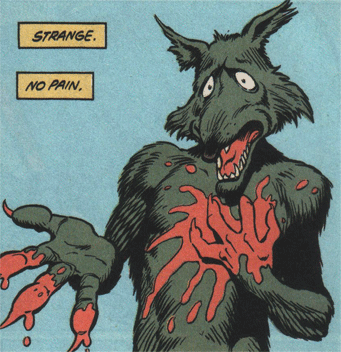 The bullet finds its mark, and the trucker collapses, mission accomplished.
The bullet finds its mark, and the trucker collapses, mission accomplished. Will he ever get up again? Given that he has nothing left to live for, it hardly seems to matter.
Will he ever get up again? Given that he has nothing left to live for, it hardly seems to matter. There's no way Buddy can know the larger importance of what he's witnessing, but he stays with Crafty as he dies, out of basic, human compassion.
 You don't need a thought bubble to read "My God, my God, why have you forsaken me" in those eyes.
You don't need a thought bubble to read "My God, my God, why have you forsaken me" in those eyes. But, as he bleeds his last, Crafty is ultimately given the peace that he sought. His God delivers to him, at last, a dignified and merciful death.



